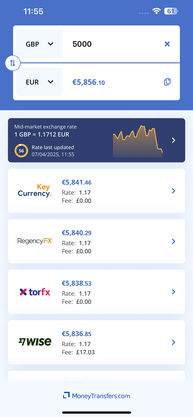USD to INR Forecast - December 2025
If you're planning to send money to India from the U.S., the exchange rate between the Indian Rupee (INR) and the U.S. Dollar (USD) is an important factor.
Here's a simple breakdown of where things stand right now, what might happen next, and how it could affect your transfers in the coming weeks.
USD/INR is currently trading at 90.34465.
Search Now & Save On Your Transfer
What is likely to happen to USD/INR in December 2025
USD to INR is likely to stay in the 89.00 to 90.40 range next month, with a slight bias toward going higher unless there is good news on US India trade talks. If you are sending money to India, current levels are attractive, and waiting carries the risk that the rupee may strengthen if trade progress improves.
USD to INR: Where It Stands
The US dollar to Indian rupee (USD to INR) is trading near record highs around 89.50 to 90.00. The rupee has been the weakest major Asian currency this year. Although the Reserve Bank of India has stepped in to slow the fall, the overall trend still points to a weaker rupee unless major positive news arrives.
What’s Driving USD to INR?
Several key factors are pushing USD to INR higher:
No US India trade deal yet. The delay is keeping foreign investors cautious and limiting dollar inflows into India.
Strong US dollar. Global uncertainty has kept demand high for the US dollar.
High US tariffs on some Indian exports. This hurts India’s trade balance and weakens the rupee.
Foreign investor outflows. Investors have been selling Indian stocks, which increases demand for dollars.
RBI intervention. The central bank is slowing the rupee’s fall but cannot completely reverse the pressure.
What Do the Charts Say?
USD to INR is still in an upward trend. Key levels to watch are:
Support at 89.60 and 88.80. If the pair drops below 88.80, rupee strength could build toward 88.30 or even 87.80.
Resistance at 90.00 to 90.40. If USD to INR rises above 90.40, it could move higher toward 91.00.
Overall, the pattern shows more upside pressure unless major positive triggers support the rupee.
What to Watch in December 2025
The biggest factors are coming up soon.
Progress on a US India trade deal. Even small signs of progress could strengthen the rupee quickly.
RBI policy decision. The bank may avoid cutting rates to protect the rupee.
US economic data. Weaker US data increases chances of a Fed rate cut, which usually helps the rupee.
Crude oil prices. Higher oil increases India’s import bill, which pressures the rupee.
Foreign investor flows. Continued outflows keep USD to INR elevated.
Risks Ahead
What could push USD to INR sharply in either direction.
Rupee could weaken more if trade talks stall or US tariffs rise.
A strong US dollar globally could pull USD to INR above 90.40.
A sharp drop in crude prices or strong progress in trade talks could strengthen the rupee faster than expected.
RBI may change its level of intervention, which could increase short term volatility.
What This Means If You’re Sending USD to INR Abroad
If you are sending US dollars to India, the current levels are favorable because the rupee is weak. This means you get more rupees for each dollar. If a US India trade deal progresses, the rupee could strengthen, which would give you fewer rupees per dollar. If trade talks stay stuck or global uncertainty rises, USD to INR may remain high or move even higher, which benefits dollar senders.
Live USD to INR exchange rates
Converting USD to INR
If you are planning to send USD to India, you need to pick the right money transfer company to get the most INR on the other end.
Depending on your needs, it's best to use one of the following companies in December:

.svg)


History of the USD to INR
The US and India are among the biggest economies in the world in terms of GDP.
The US has a combined GDP of over $23 trillion while India recently overtook the UK to become the fifth biggest economy in the world after the US, China, Japan, and Germany.
India has a GDP of over $3.5 trillion as of 2022.
The USD to INR is therefore an important currency cross because of the vast volume of trade that happens between the two countries.
This volume started growing in the 1990s when India started to reopen its economy.
While India’s economy has been growing, its currency has been in a downward trend over the years.
Today, it is trading at about 82 against the US Dollar.
The Indian rupee has dropped by 28% in the past five years against the U.S. dollar.
It has also dropped by about 9% in the past 12 months even after the Federal Reserve and the Reserve Bank of India (RBI) have embraced an extremely hawkish tone.
The USD/INR pair is often influenced by a number of factors, including the actions of the Fed and RBI, economic numbers between the two countries, and global macro factors.
It is also affected by the overall trade volume between the US and India, which averages over $146 billion per year.
| Date | 1 US Dollar in INR |
|---|---|
| Dec 03, 2025 | 90.170750 INR |
| Dec 04, 2025 | 89.836650 INR |
| Dec 05, 2025 | 89.958504 INR |
| Dec 06, 2025 | 89.958504 INR |
| Dec 07, 2025 | 89.945497 INR |
| Dec 08, 2025 | 90.130250 INR |
| Dec 09, 2025 | 89.917150 INR |
| Dec 10, 2025 | 89.793250 INR |
| Dec 11, 2025 | 90.253250 INR |
| Dec 12, 2025 | 90.344650 INR |

Our handy, modern currency app lets you:
Instantly convert 25,000+ currency pairs
Compare live transfer deals
Get reviews & insights
Our app is free for mobiles and tablets, with no intrusive ads or in-app purchases.
Related Content




Contributors





